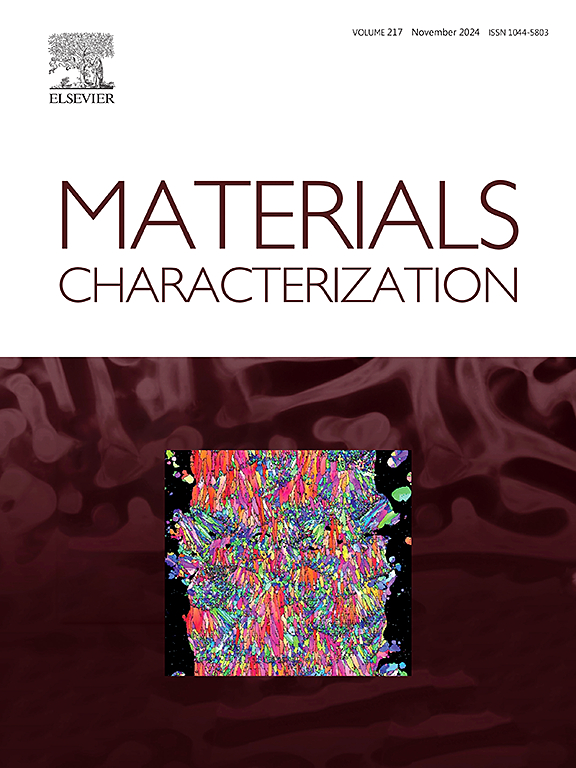全面提高了Al 0的机械性能、耐磨性和耐腐蚀性。2₅FeCoNiVTiₓ通过Ti合金化的高熵合金
IF 4.8
2区 材料科学
Q1 MATERIALS SCIENCE, CHARACTERIZATION & TESTING
引用次数: 0
摘要
航空航天和海洋工业的发展增加了对耐磨损和耐腐蚀材料的需求。高熵合金(HEAs)由于其多组分性质和可调的微观结构而具有巨大的工业应用潜力。本研究系统地研究了Ti合金化对Al 0组织、力学性能、耐磨性和耐腐蚀性的影响。₂₅FeCoNiVTiₓ头脑(x = 0、0.1、0.3、0.5和0.7)。Ti含量的增加显著促进了体心立方相的形成,从而协同提高了硬度、耐磨性和耐腐蚀性。艾尔₀。₂₅FeCoNiVTi₀。与基础合金(Al₀.₂₅FeCoNiV)相比,₇合金的硬度提高了136%,磨损率降低了95.2%,腐蚀电流密度降低了77.4%,极化电阻增加了164.1%。利用扫描电子显微镜、电子背散射衍射和x射线光电子能谱进行综合表征,结合摩擦热生成、接触应力和裂纹扩展阻力的定量分析,阐明了潜在的机制。从黏着磨料磨损到氧化磨损的转变,再加上材料强度和抗磨损损伤能力的增强,导致了优异的磨损性能。耐蚀性的提高主要归功于Ti合金化,优化了钝化膜的成分,显著提高了钝化膜的致密性、化学稳定性和耐蚀性。该研究为设计具有优异硬度、耐磨性和耐腐蚀性的HEAs提供了理论基础。本文章由计算机程序翻译,如有差异,请以英文原文为准。
Comprehensive enhancement of mechanical properties, wear resistance, and corrosion resistance in Al₀.₂₅FeCoNiVTiₓ high-entropy alloy through Ti alloying
The advancement of the aerospace and marine industries has increased the demand for materials with exceptional resistance to both abrasion and corrosion. High-entropy alloys (HEAs) hold significant potential for industrial applications due to their multi-component nature and tunable microstructures. This study systematically investigates the effects of Ti alloying on the microstructure, mechanical properties, wear resistance, and corrosion resistance of Al₀.₂₅FeCoNiVTiₓ HEAs (x = 0, 0.1, 0.3, 0.5, and 0.7). Increasing Ti content notably promotes the formation of the body-centered cubic phase, achieving synergistic enhancements in hardness, wear resistance, and corrosion resistance. The Al₀.₂₅FeCoNiVTi₀.₇ alloy demonstrates a remarkable 136 % increase in hardness, a 95.2 % reduction in wear rate, and a 67.4 % decrease in corrosion current density compared to the base alloy (Al₀.₂₅FeCoNiV), alongside a 164.1 % increase in polarization resistance. Comprehensive characterization using scanning electron microscope, electron backscatter diffraction, and X-ray photoelectron spectroscopy, combined with quantitative analyses of frictional heat generation, contact stress, and crack extension resistance, elucidates the underlying mechanisms. The transition from adhesive-abrasive wear to oxidative wear, coupled with enhanced material strength and resistance to wear damage, accounts for the superior wear performance. The improved corrosion resistance is primarily attributed to Ti alloying, which optimizes the passivation film's composition, significantly enhancing its densification, chemical stability, and corrosion resistance. This study provides a theoretical foundation for designing HEAs with exceptional hardness, wear resistance, and corrosion resistance.
求助全文
通过发布文献求助,成功后即可免费获取论文全文。
去求助
来源期刊

Materials Characterization
工程技术-材料科学:表征与测试
CiteScore
7.60
自引率
8.50%
发文量
746
审稿时长
36 days
期刊介绍:
Materials Characterization features original articles and state-of-the-art reviews on theoretical and practical aspects of the structure and behaviour of materials.
The Journal focuses on all characterization techniques, including all forms of microscopy (light, electron, acoustic, etc.,) and analysis (especially microanalysis and surface analytical techniques). Developments in both this wide range of techniques and their application to the quantification of the microstructure of materials are essential facets of the Journal.
The Journal provides the Materials Scientist/Engineer with up-to-date information on many types of materials with an underlying theme of explaining the behavior of materials using novel approaches. Materials covered by the journal include:
Metals & Alloys
Ceramics
Nanomaterials
Biomedical materials
Optical materials
Composites
Natural Materials.
 求助内容:
求助内容: 应助结果提醒方式:
应助结果提醒方式:


